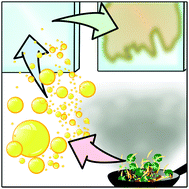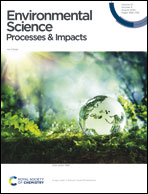Glass surface evolution following gas adsorption and particle deposition from indoor cooking events as probed by microspectroscopic analysis†
Abstract
Indoor surfaces are extremely diverse and their interactions with airborne compounds and aerosols influence the lifetime and reactivity of indoor emissions. Direct measurements of the physical and chemical state of these surfaces provide insights into the underlying physical and chemical processes involving surface adsorption, surface partitioning and particle deposition. Window glass, a ubiquitous indoor surface, was placed vertically during indoor activities throughout the House Observations of Microbial and Environmental Chemistry (HOMEChem) campaign and then analyzed to measure changes in surface morphology and surface composition. Atomic force microscopy-infrared (AFM-IR) spectroscopic analyses reveal that deposition of submicron particles from cooking events is a contributor to modifying the chemical and physical state of glass surfaces. These results demonstrate that the deposition of glass surfaces can be an important sink for organic rich particles material indoors. These findings also show that particle deposition contributes enough organic matter from a single day of exposure equivalent to a uniform film up to two nanometers in thickness, and that the chemical distinctness of different indoor activities is reflective of the chemical and morphological changes seen in these indoor surfaces. Comparison of the experimental results to physical deposition models shows variable agreement, suggesting that processes not captured in physical deposition models may play a role in the sticking of particles on indoor surfaces.

- This article is part of the themed collection: Best Papers 2020 – Environmental Science: Processes & Impacts


 Please wait while we load your content...
Please wait while we load your content...
